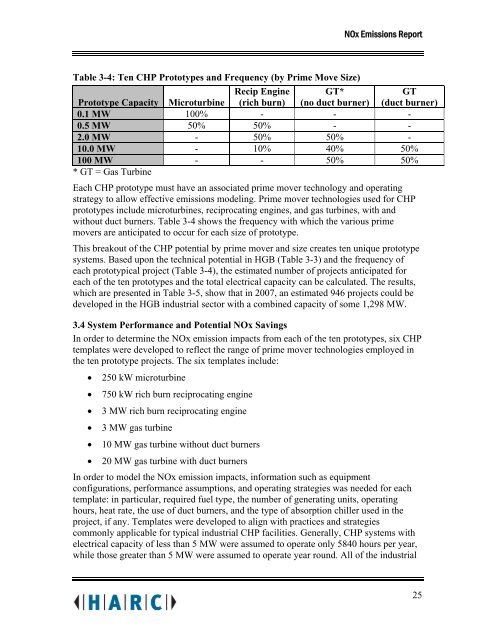NOx Emissions Impacts from Widespread Deployment of CHP in ...
NOx Emissions Impacts from Widespread Deployment of CHP in ...
NOx Emissions Impacts from Widespread Deployment of CHP in ...
Create successful ePaper yourself
Turn your PDF publications into a flip-book with our unique Google optimized e-Paper software.
Table 3-4: Ten <strong>CHP</strong> Prototypes and Frequency (by Prime Move Size)<br />
<strong>NOx</strong> <strong>Emissions</strong> Report<br />
Recip Eng<strong>in</strong>e GT*<br />
GT<br />
Prototype Capacity Microturb<strong>in</strong>e (rich burn) (no duct burner) (duct burner)<br />
0.1 MW 100% - - -<br />
0.5 MW 50% 50% - -<br />
2.0 MW - 50% 50% -<br />
10.0 MW - 10% 40% 50%<br />
100 MW<br />
* GT = Gas Turb<strong>in</strong>e<br />
- - 50% 50%<br />
Each <strong>CHP</strong> prototype must have an associated prime mover technology and operat<strong>in</strong>g<br />
strategy to allow effective emissions model<strong>in</strong>g. Prime mover technologies used for <strong>CHP</strong><br />
prototypes <strong>in</strong>clude microturb<strong>in</strong>es, reciprocat<strong>in</strong>g eng<strong>in</strong>es, and gas turb<strong>in</strong>es, with and<br />
without duct burners. Table 3-4 shows the frequency with which the various prime<br />
movers are anticipated to occur for each size <strong>of</strong> prototype.<br />
This breakout <strong>of</strong> the <strong>CHP</strong> potential by prime mover and size creates ten unique prototype<br />
systems. Based upon the technical potential <strong>in</strong> HGB (Table 3-3) and the frequency <strong>of</strong><br />
each prototypical project (Table 3-4), the estimated number <strong>of</strong> projects anticipated for<br />
each <strong>of</strong> the ten prototypes and the total electrical capacity can be calculated. The results,<br />
which are presented <strong>in</strong> Table 3-5, show that <strong>in</strong> 2007, an estimated 946 projects could be<br />
developed <strong>in</strong> the HGB <strong>in</strong>dustrial sector with a comb<strong>in</strong>ed capacity <strong>of</strong> some 1,298 MW.<br />
3.4 System Performance and Potential <strong>NOx</strong> Sav<strong>in</strong>gs<br />
In order to determ<strong>in</strong>e the <strong>NOx</strong> emission impacts <strong>from</strong> each <strong>of</strong> the ten prototypes, six <strong>CHP</strong><br />
templates were developed to reflect the range <strong>of</strong> prime mover technologies employed <strong>in</strong><br />
the ten prototype projects. The six templates <strong>in</strong>clude:<br />
• 250 kW microturb<strong>in</strong>e<br />
• 750 kW rich burn reciprocat<strong>in</strong>g eng<strong>in</strong>e<br />
• 3 MW rich burn reciprocat<strong>in</strong>g eng<strong>in</strong>e<br />
• 3 MW gas turb<strong>in</strong>e<br />
• 10 MW gas turb<strong>in</strong>e without duct burners<br />
• 20 MW gas turb<strong>in</strong>e with duct burners<br />
In order to model the <strong>NOx</strong> emission impacts, <strong>in</strong>formation such as equipment<br />
configurations, performance assumptions, and operat<strong>in</strong>g strategies was needed for each<br />
template: <strong>in</strong> particular, required fuel type, the number <strong>of</strong> generat<strong>in</strong>g units, operat<strong>in</strong>g<br />
hours, heat rate, the use <strong>of</strong> duct burners, and the type <strong>of</strong> absorption chiller used <strong>in</strong> the<br />
project, if any. Templates were developed to align with practices and strategies<br />
commonly applicable for typical <strong>in</strong>dustrial <strong>CHP</strong> facilities. Generally, <strong>CHP</strong> systems with<br />
electrical capacity <strong>of</strong> less than 5 MW were assumed to operate only 5840 hours per year,<br />
while those greater than 5 MW were assumed to operate year round. All <strong>of</strong> the <strong>in</strong>dustrial<br />
25
















